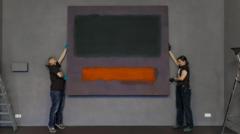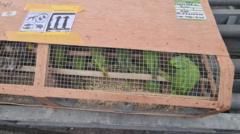The incident raises questions about how institutions manage the display of valuable artworks, particularly in publicly accessible areas.
Child Accidentally Damages €50 Million Rothko Painting at Rotterdam Museum

Child Accidentally Damages €50 Million Rothko Painting at Rotterdam Museum
A young child inadvertently scratches a valuable Rothko painting in a Dutch museum, prompting discussions on art safety and restoration.
In a shocking turn of events at the Museum Boijmans Van Beuningen in Rotterdam, a child has inadvertently caused damage to Mark Rothko's esteemed painting, Grey, Orange on Maroon, No. 8, valued at an astounding €50 million (£42.5 million). The incident, described as occurring during an "unguarded moment," has led museum officials to contemplate their next steps for restoration, according to reports from local media, including Algemeen Dagblad.
The spokesperson for the museum confirmed that the damages are described as "superficial," consisting of small scratches located on the unvarnished paint layer at the lower section of the artwork. "We have sought conservation expertise both domestically and internationally," the spokesperson stated, adding that they are exploring ways to treat the painting. The museum remains optimistic that the artwork will be displayed again in the future.
Sophie McAloone, conservation manager at the Fine Art Restoration Company, highlighted the inherent vulnerability of modern unvarnished paintings, such as Rothko's. She explained that their complex materials and lack of a protective coating make even minor damages significantly noticeable. Consequently, scratching on Rothko's work can severely impact the visual experience, demanding meticulous restoration efforts.
This incident has broader implications for cultural institutions, particularly in the UK, where galleries like V&A East and the British Museum are considering more open displays of previously archived works. Jonny Helm, a marketing manager at an art restoration service, pointed out potential challenges for conservators. According to him, Rothko's intricate pigment mixtures alongside the unvarnished surface raises the complexity of the restoration process.
Conservators will likely document the damage and investigate successful past treatments for Rothko's artwork to guide their restoration efforts. This is not the first instance of Rothko's works encountering misfortune; a similar situation occurred in 2012 when Rothko's Black on Maroon was vandalized at the Tate Modern.
Rachel Myrtle, Head of Specie and Fine Arts at Aon, elaborated on the insurance aspects, noting that art policies generally encompass risks linked to physical loss or damage, including accidental harm caused by visitors. Although the museum has refrained from commenting on liability for the recent damage, it is worth noting that accountability has previously been enforced. For instance, in 2011, the museum requested payment from a visitor who accidentally damaged an artwork.
The museum characterizes Rothko's piece as an example of color field painting, an art movement defined by expansive blocks of flat color on a canvas. This incident is part of a worrying trend in the Netherlands, where various artworks, including pieces by Andy Warhol, have experienced damage due to vandalism and accidents.
Policies surrounding damage caused by minors vary across institutions. In an earlier incident in Israel, a young child fractured a significant ancient artifact, but the museum opted for a gentle approach rather than punitive measures. As museums navigate the delicate balance between making art accessible and preserving their collections, this latest Rothko incident prompts urgent reflections on safeguarding invaluable cultural treasures.
The spokesperson for the museum confirmed that the damages are described as "superficial," consisting of small scratches located on the unvarnished paint layer at the lower section of the artwork. "We have sought conservation expertise both domestically and internationally," the spokesperson stated, adding that they are exploring ways to treat the painting. The museum remains optimistic that the artwork will be displayed again in the future.
Sophie McAloone, conservation manager at the Fine Art Restoration Company, highlighted the inherent vulnerability of modern unvarnished paintings, such as Rothko's. She explained that their complex materials and lack of a protective coating make even minor damages significantly noticeable. Consequently, scratching on Rothko's work can severely impact the visual experience, demanding meticulous restoration efforts.
This incident has broader implications for cultural institutions, particularly in the UK, where galleries like V&A East and the British Museum are considering more open displays of previously archived works. Jonny Helm, a marketing manager at an art restoration service, pointed out potential challenges for conservators. According to him, Rothko's intricate pigment mixtures alongside the unvarnished surface raises the complexity of the restoration process.
Conservators will likely document the damage and investigate successful past treatments for Rothko's artwork to guide their restoration efforts. This is not the first instance of Rothko's works encountering misfortune; a similar situation occurred in 2012 when Rothko's Black on Maroon was vandalized at the Tate Modern.
Rachel Myrtle, Head of Specie and Fine Arts at Aon, elaborated on the insurance aspects, noting that art policies generally encompass risks linked to physical loss or damage, including accidental harm caused by visitors. Although the museum has refrained from commenting on liability for the recent damage, it is worth noting that accountability has previously been enforced. For instance, in 2011, the museum requested payment from a visitor who accidentally damaged an artwork.
The museum characterizes Rothko's piece as an example of color field painting, an art movement defined by expansive blocks of flat color on a canvas. This incident is part of a worrying trend in the Netherlands, where various artworks, including pieces by Andy Warhol, have experienced damage due to vandalism and accidents.
Policies surrounding damage caused by minors vary across institutions. In an earlier incident in Israel, a young child fractured a significant ancient artifact, but the museum opted for a gentle approach rather than punitive measures. As museums navigate the delicate balance between making art accessible and preserving their collections, this latest Rothko incident prompts urgent reflections on safeguarding invaluable cultural treasures.




















